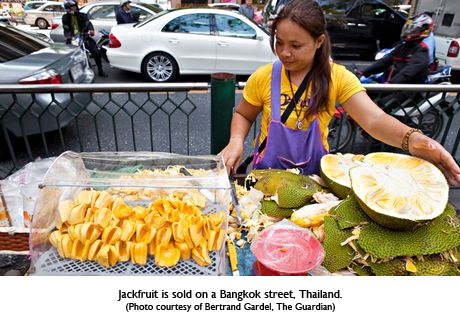It’s big and bumpy with a gooey interior and a powerful smell of decay – but it could help keep millions of people from hunger.
Researchers say jackfruit – a large ungainly fruit grown across south and south-east Asia – could be a replacement for wheat, corn and other staple crops under threat from climate change.
 The World Bank and United Nations warned recently that rising temperatures and unpredictable rainfall had already reduced yields of wheat and corn, and could lead to food wars within the decade.
The World Bank and United Nations warned recently that rising temperatures and unpredictable rainfall had already reduced yields of wheat and corn, and could lead to food wars within the decade.
Now researchers say jackfruit could help provide the solution.
Jackfruit is the largest known treeborne fruit. Even a small jackfruit weighs in at 10-15lbs (5-7kg), and farmers have recorded specimens of more than 100lbs (45kg).
“It’s a miracle. It can provide so many nutrients and calories – everything,” said Shyamala Reddy, a biotechnology researcher at the University of Agriculture Sciences in Bangalore, India. “If you just eat 10 or 12 bulbs of this fruit, you don’t need food for another half a day.”
But jackfruit, despite its huge potential, remains underexploited as a food crop in India, where it originated.
That is beginning to change, however, with a growing number of researchers looking for alternatives.
Reddy’s university will host an international conference on jackfruit in May. She said the Indian government had launched a number of new initiatives to promote the crop by expanding its use as a canned vegetable and as a processed food.
The effort coincides with a global push to expand food production, especially in developing countries which are expected to face growing challenges to feed their people in the coming decades.
Jackfruit can fill the gap on a number of counts, said Danielle Nierenberg, president of Food Tank, which works on sustainable agriculture.
“It is easy to grow. It survives pests and diseases and high temperatures. It is drought-resistant,” she said. “It achieves what farmers need in food production when facing a lot of challenges under climate change.”
The fruit is rich in potassium, calcium, and iron, said Reddy, making it more nutritious than current starchy staples.
Sri Lanka and Vietnam have established jackfruit industries, where the fruit is processed into products as diverse as flour, noodles, papad and ice cream. Jackfruit is also canned and sold as a vegetable for export.
But jackfruit remains a hard sell in much of India. Although the fruit was seen as an important staple 40 or 50 years ago, it is now derided as a poor man’s fruit, said Shree Padre, a jackfruit farmer from Karnataka.
Only one or two commercial-scale jackfruit plantations are in current operation.
“In the country of origin, it is just not understood,” he said. “There is an inferiority attached to jackfruit. Any farmer would happily carry an imported apple in his hand rather than jackfruit.”
The down-market reputation is unwarranted, said Nyree Zyrega, a researcher on plant biology at the Chicago Botanic Garden, who has studied jackfruit in Bangladesh.
In addition to its high nutritional value, the fruit is very versatile, she said. The seeds, young fruit, and mature varieties are all edible. The timber from jackfruit trees is also valuable. “It is just not being utilised,” she said.
“I think it could play a much more important role in diets than it currently does and be a staple,” she continued. “In addition to consuming cooked young jackfruit, ripe jackfruit, and jackfruit seeds, there are also many food products with longer shelf life that can be made from jackfruit.”
Processing the fruit can be offputting, she conceded. The larger fruit give off a strong odour, and ooze a thick white sap. “It is not the easiest fruit,” Zyrega said.
But jackfruit, breadfruit, and other non-traditional crops are being reexamined because of fears about future food supply.
A report from the International Panel on Climate Change last month warned that heatwaves, drought, and unpredictable rainfall patterns were already cutting into yields of wheat and maize. The World Bank’s Dr Jim Yong Kim earlier this month predicted food shortages could lead to wars within the next five to 10 years.
“There is just more interest in crops that aren’t the major staples,” she said. “We just don’t have a choice. We are going to have to explore some of these alternative to make sure we are going to be able to nourish people,” Nierenberg said.
Source: The Guardian
